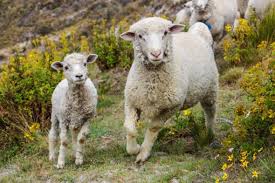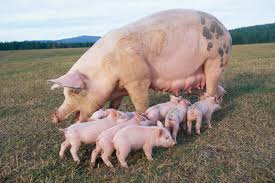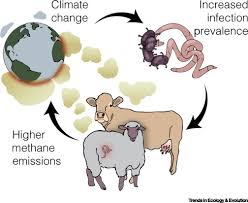A disease can be described as a condition resulting in a deviation from the normal functional or behavioural status of an animal. Disease can be infectious or noninfectious.
Infectious diseases are those caused by pathogenic microorganisms such as bacteria, viruses, protozoa and fungi that invade an animal’s body and can spread from one animal to another directly or indirectly (contagious).
Noninfectious diseases, on the other hand, are not caused by pathogens; rather, they can result from nutritional deficiencies, the environment or are inherited (genetics).
A pathogen is a disease-causing microbial agent. This article presents the different ways diseases are classified and the methods of disease transmission in animals.
Causes of Diseases in Livestock
Diseases are caused mostly by pathogenic microorganisms or parasites which invade, colonize and multiply within the host cells (animal cells), causing a significant change in the body. These pathogens can be bacteria, virus, fungi, protozoa or even a parasite.
The first person to associate a particular microbe with a particular disease was Robert Koch in 1877. He attributed the disease anthrax to the organism called Bacillus anthracis.
The manner in which a disease develops (pathogenesis) differs with different diseases. Other causes of diseases include injuries, poisons/chemicals, poor nutrition or genetics.
Read Also: 18 Medicinal Health Benefits Of Maidenhair Tree (Ginkgo Biloba)
Methods of Disease Transmission in Livestock

Diseases are transmitted from one animal to another through the following ways:
1. Contact Transmission: This can be by direct contact between animals that are staying together in the herd or flock, or when they meet in the open field during grazing, or even at animal markets.
It can also be indirect contact when animals come in contact with other objects that a sick animal has had contact with. These objects can be non-living (fomite) such as syringes, boots worn by attendants, feeding troughs, pasture etc.
2. Vehicular Transmission: This type of transmission occurs via a medium, which can be through feed (food poisoning), water, air (spores), fluids (saliva) etc.
3. Vectors: This type of transmission refers to other animals that carry disease-causing agents from one host to another, and the majority of these are insects or arthropods. They transmit these pathogenic microorganisms and/or parasites either mechanically or biologically.
In mechanical transmission, they passively carry the pathogen on their body parts, while in biological transmission which usually involves biting actions, part of the life cycle of the pathogen occurs within the body of the vector.
An example of this is the transmission of malaria by mosquitoes or trypanosomosis by tsetse fly (Glossina species).
Read Also: 19 Medicinal Health Benefits Of Avens (Geum)
Classification of Livestock Diseases Based on Various Criteria

Livestock diseases can be classified using different criteria depending on what best satisfies the situation under consideration. Consequently, diseases can be classified based on the species of animals (avian diseases, bovine diseases, equine diseases, caprine diseases etc); system of the body affected (cardiovascular diseases, respiratory diseases, reproductive diseases etc); and the causative organism.
However, the etiology or causative organism is the most widely used method of classification. Here, they are classified as:
1. Bacterial diseases: example: Anthrax, Mastitis, Salmonellosis, Fowl typhoid etc
2. Viral diseases: example: Foot and Mouth Disease, Rinderpest, African swine fever etc
3. Protozoan diseases example: Coccidiosis, Trypanosomosis, Babesiosis etc
4. Rickettsial diseases: example: Anaplasmosis, Cowdriosis, Infectious keratoconjunctivitis
5. Fungal diseases: example: Aspergillosis, Ringworm, Epizootic lymphangitis
6. Endoparasitic diseases (caused by worms): example: Fascioliosis, Haemonchosis etc
7. Ectoparasitic diseases (caused by ticks, lice, fleas): example: Mange, fleabite dermatitis etc
8. Deficiency diseases: – example: Vitamin deficiencies, pregnancy toxaemia etc
9. Toxicoses: example: Nitrate poisoning
Classification of Livestock Diseases Based on Prevention Strategies
Livestock diseases can also be classified on the basis of disease prevention into six categories, which are:
1. Neonatal diseases: diseases that affect very young animals, mainly diarrhoeal in nature
2. Vector-borne diseases: diseases transmitted by a living vector such as trypanosomosis
3. Soil-borne diseases: diseases mostly caused by aerobic and anaerobic spore-forming bacteria (e.g. botulism)
4. Contact diseases: usually responsible for serious epidemic diseases in livestock in the tropics such as Rinderpest, Foot and Mouth Disease etc
5. Parasitic diseases: similar to contact diseases; examples include haemonchosis, fascioliosis etc
This article has explained that diseases are caused by several factors ranging from microbial pathogens to poor nutrition. Diseases are either infectious or noninfectious depending on the cause and their ability to spread.
It has also been explained that diseases can be transmitted through contact, vectors or inanimate vehicles. Furthermore, this article described the basis of classification of diseases such as the causative organism, the species of livestock, and the system of the body affected.
Do you have any questions, suggestions, or contributions? If so, please feel free to use the comment box below to share your thoughts. We also encourage you to kindly share this information with others who might benefit from it. Since we can’t reach everyone at once, we truly appreciate your help in spreading the word. Thank you so much for your support and for sharing!

